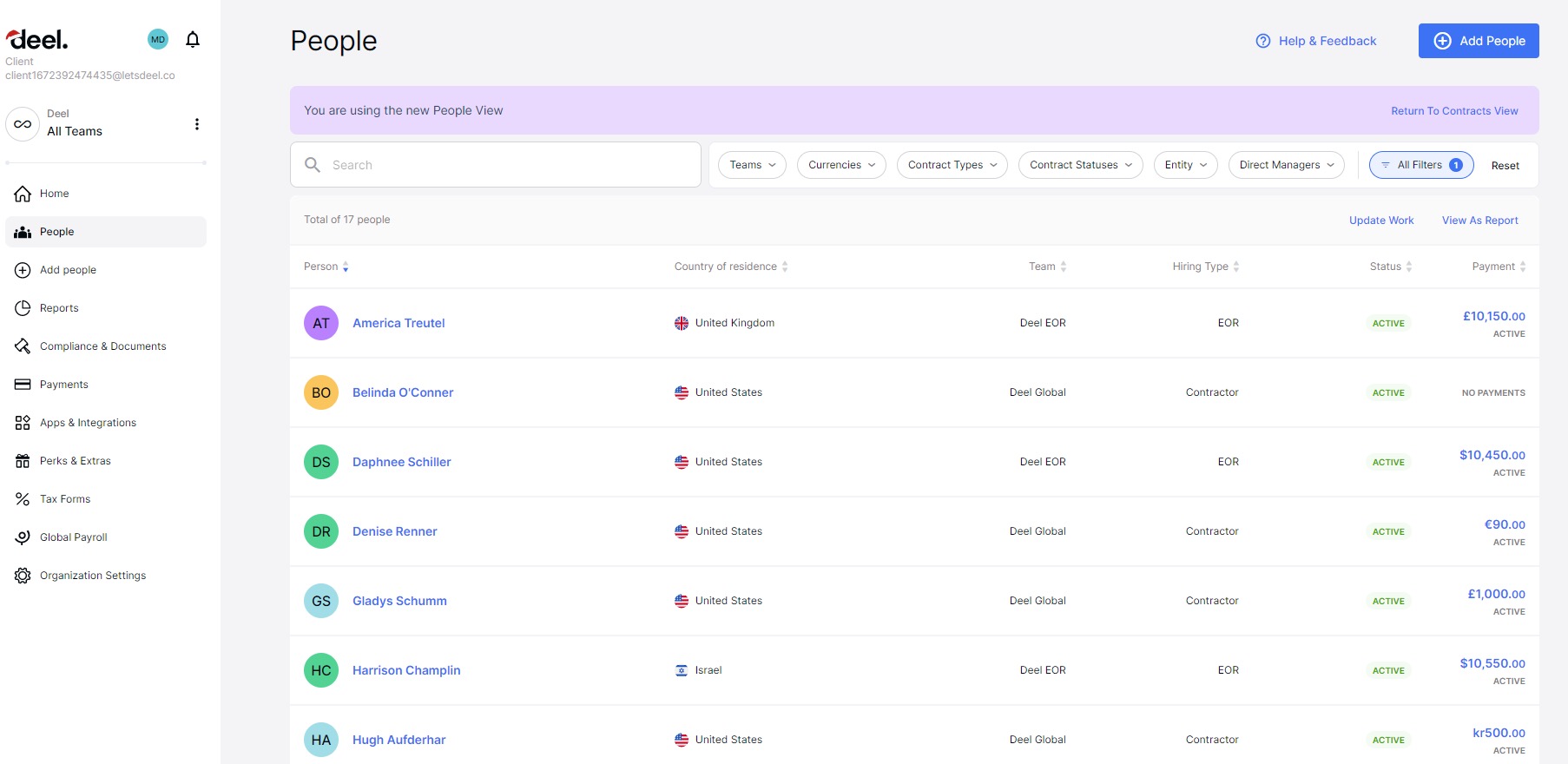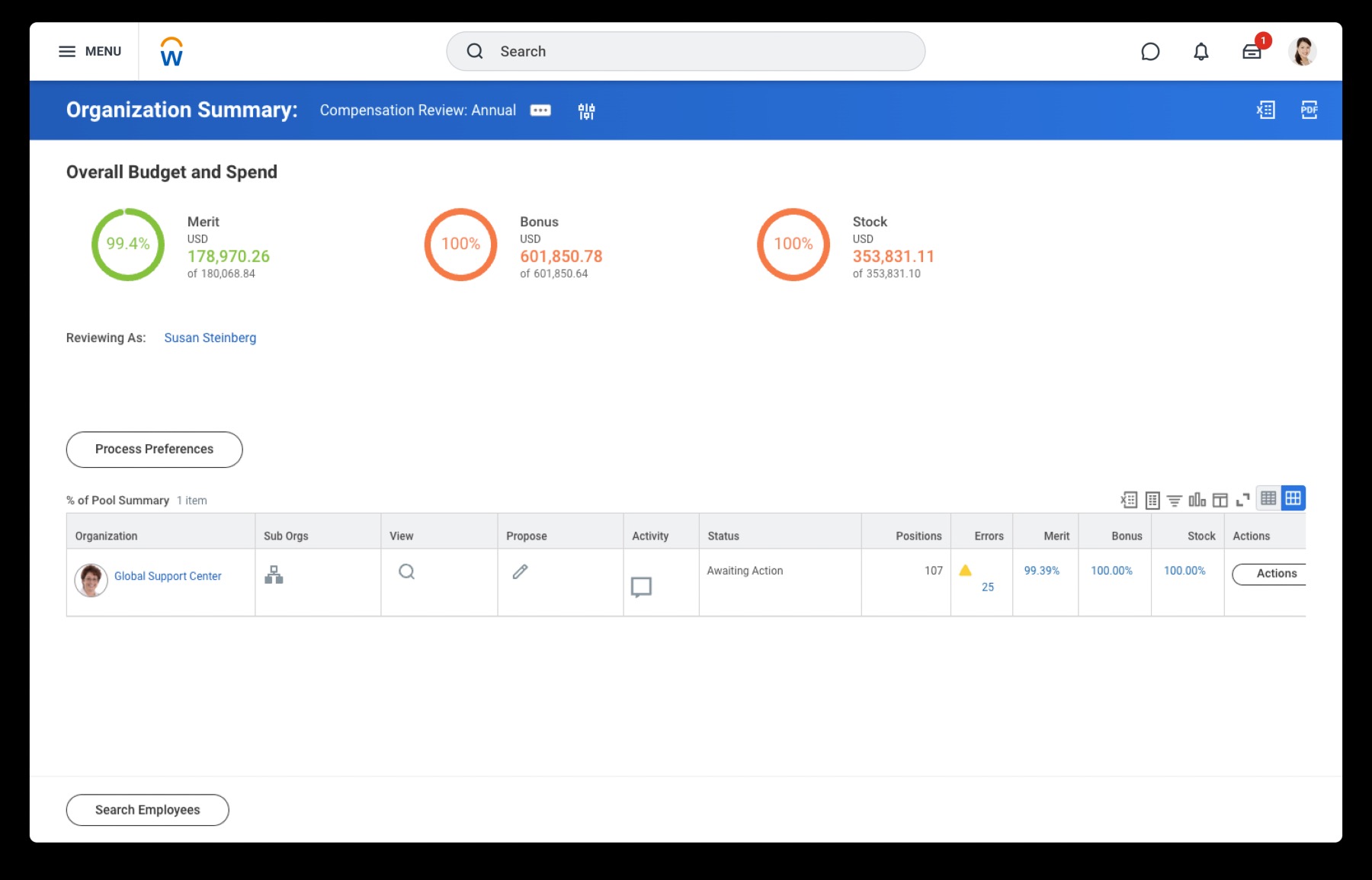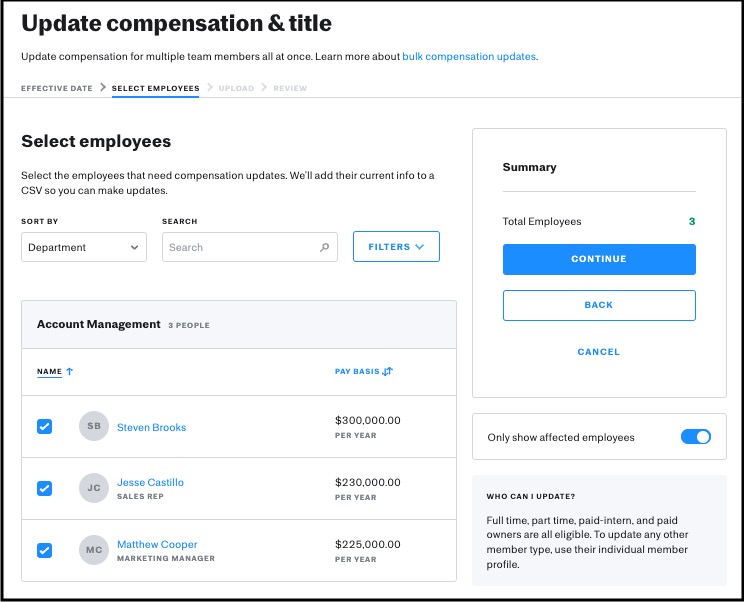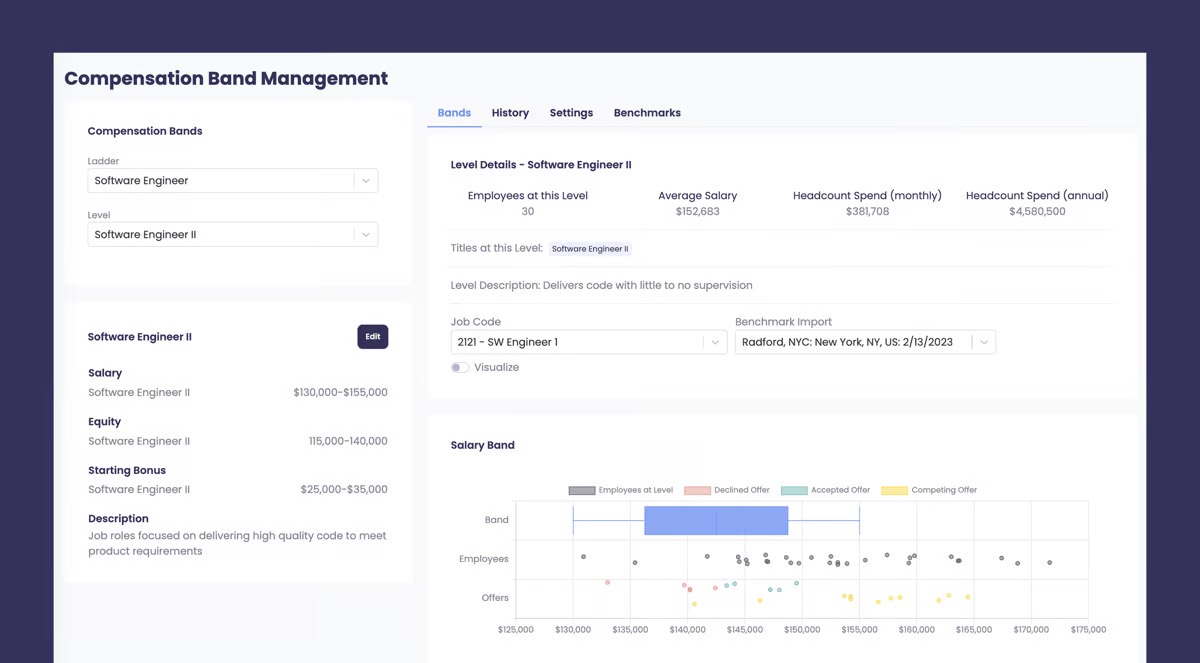Compensation errors significantly affect employee experience. In fact, 44% of employees would consider leaving their jobs due to incorrect pay.[1]
These errors can also cause a dip in team morale and a fracture in the cohesion that fuels organizational success. So, how do you prevent them?
Compensation management software automates complex compensation tasks and avoids the pitfalls of manual calculations.
In this guide, we discuss the benefits of a compensation management platform, explain how to leverage this HR technology, review the best compensation management software, and answer the most common questions you may have.
We also explain how you can use talent assessments to identify top performers and create a reward system using compensation management software.
Table of contents
- What is compensation management software?
- Why is compensation management software important to HR professionals?
- The benefits of compensation management tools
- 5 best compensation management software
- 5 best practices for leveraging compensation management software in your HR department
- 3 examples of companies succeeding with compensation management software
- Use compensation management software to reduce costly errors
- Compensation management software FAQs
What is compensation management software?
Compensation management software automates all tasks surrounding the compensation process, ensuring precision and efficiency. It replaces having to spend countless hours on tedious manual tasks, which enables HR teams to focus on more strategic and impactful initiatives.
Although most people view it as a system to manage salaries, benefits, and bonuses, this is only one part of what it can do.
Compensation management software is also crucial for embracing a culture of fair and transparent compensation practices, improving employee engagement, and rewarding good performance.
The most important features of compensation management software include:
Automated compensation planning, which helps streamline the planning process to eliminate manual errors.
Transparent compensation structure. Foster employee engagement and trust by clearly communicating pay systems and decision-making processes.
Performance-based reward systems that create incentives based on skills and performance, which motivates employees.
Integration. Aligning with other human resources systems creates a cohesive HR tech stack.
Data security, prioritizing employee privacy and protecting sensitive compensation information.
Why is compensation management software important to HR professionals?
Compensation management software helps HR professionals address the critical challenges of traditional compensation approaches, like poor accuracy and long duration.
Workers compensation management software ensures employees receive rewards based on their skills and performance. When employees feel recognized and rewarded for their hard work, it strengthens their loyalty and motivates them to continue doing a good job.
This HR management tool also protects the security of compensation information and mitigates the risks associated with manual handling and storage. That, in turn, protects employees’ privacy and the organization’s integrity.
Lastly, compensation management software improves the visibility of HR processes, providing a clear view of compensation workflows. The ensuing transparency and accountability enable agile adjustments when business needs shift.
The best insights on HR and recruitment, delivered to your inbox.
Biweekly updates. No spam. Unsubscribe any time.
The benefits of compensation management tools
Using a compensation management platform has several advantages for businesses looking to stay ahead of the competition.
Here’s how compensation management software can benefit your company.
1. Improves speed and efficiency
Automation has become one of the leading HR technology trends in the past few years due to the pressing need for better processes, accuracy, and time savings. This is mainly present in the finance sector, where we’ve seen a 659% increase in HR automation.
As organizations face workforce management challenges, it’s crucial to have HR tools to make this process more efficient.
Compensation management software automates compensation planning, calculation, and distribution, which significantly reduces the time spent on these labor-intensive tasks.
That being said, it’s not just about speed. HR automation also helps make the process more accurate, reducing issues – and not wasting time and money to fix these costly mistakes.
By embracing automation like compensation management software, companies can save $46,000 annually.[2]
2. Reduces error
According to Aptitude’s Payroll Index Report, in-house payroll systems had almost twice the error rate of third-party software (11.4% compared with 6.1%).[3]
Compensation errors can undermine employee trust, hurt team cohesion, and affect organizational compliance. These issues can have far-reaching consequences, affecting the success of your company.
Compensation management software introduces automation into the mix, eliminating the need to manually add error-prone data into spreadsheet templates.
These tools use precise calculations and algorithms to determine various aspects like bonuses and salary adjustments. They also adhere to compensation policies and regulatory requirements.
Access to real-time data ensures the software operates on the most current and accurate information. This minimizes errors associated with outdated data and enables swift corrections when needed.
3. Helps you make informed decisions
Unfair pay compensation contributes to voluntary turnover. In fact, improving compensation transparency could reduce employee flight risk by 27%.[4]
However, navigating the nuanced landscape of compensation decisions requires insight, accuracy, and a strategic approach.
Compensation management software provides access to real-time data on salaries, bonuses, and incentives, enabling you to make decisions based on the most current and relevant insights.
Most software offers performance metrics and analytics tools. HR professionals can use these to gain insights into total compensation trends, individual performance levels, and the overall impact of compensation strategies on organizational objectives.
4. Boosts employee engagement
When employees feel they are compensated fairly, they are more likely to be engaged and satisfied in their work.[5]
Businesses with engaged workforces are 23% more profitable than companies with disengaged workers.[6]
Compensation management software ensures everyone’s paycheck reflects what they bring to the table. It’s a way of saying that you value the effort of your employees and are ready to reward them adequately.
Keep in mind that your employees measure their salary against the market rates for their job title, experience, and position responsibilities. An employee compensation management system can compare these metrics and verify your compensation policies are fair.
Although a higher salary can contribute to employee engagement, it’s important to recognize that workplace satisfaction depends on various factors. These include company culture, transparent communication practices, opportunities for professional growth, supportive leadership, and good work-life balance.
5 best compensation management software
Choosing the right compensation management tool helps your company align compensation strategies with organizational goals.
This section explores the top five compensation management software, each offering unique features to optimize salary and benefit administration processes.
Factors we considered
Here’s how we picked top compensation management software for this list:
User-friendly interface. Compensation management is often complex, so we want software that’s easy to use. A user-friendly interface supports a positive user experience and higher adoption rates.
Competitive features. Systems with global salary benchmarking; pay equity tools; diversity, equity, and inclusion (DEI) monitoring tools; and other useful features provide more benefits.
Software integrations. The ability to integrate with payroll software, performance management systems, and other automation tools is vital for a cohesive tech stack.
Customization options. Every organization is unique, and their compensation structures reflect that. We list compensation software that supports flexibility and customization to align with your company’s policies and practices.
Analytics and reporting. These tools enable HR professionals to make informed decisions based on real-time data.
Cost-effectiveness. Although not all software is transparent about their pricing structures, we tried to find the products that strike the right value balance.
The summary of top compensation management software
Compensation management software | Category | Summary |
1. Lattice | Best overall | Lattice integrates performance and compensation management, offering a unified approach to reward employees based on their contributions |
2. Deel | Best for international teams | Deel simplifies global payroll for diverse teams, supporting multiple currencies and compliance with varying legal and tax requirements across jurisdictions |
3. Workday | Best for scaling businesses | Workday’s cloud-based platform aligns compensation strategies with financial planning, offering collaborative data modeling and people analytics for informed decisions |
4. Justworks | Best for small companies | Justworks is an easy-to-use platform for small to mid-sized businesses, offering payroll, benefits, and compliance management |
5. Aeqium | Best for corporate teams | Aeqium is a flexible cloud-based software that aids HR teams in making better compensation decisions with advanced integrations, employee performance metrics, and detailed reporting |
Lattice: Best overall
Lattice is a comprehensive performance management platform that helps businesses create high-performing workplaces.
This software also incorporates employee compensation management, providing a unified approach to tracking performance and rewarding employees based on their contributions.
Lattice combines various HR tools into one, helping you streamline your HR workflow. With a user-friendly interface, the platform enables users to create and manage workflows for determining and adjusting pay, which ensures consistency and clarity for managers and employees.
This compensation management software includes benchmarking data, simple record keeping, bonus and equity management, raise guidance, and employee self-service.
Pros
User-friendly interface
Compatibility with multiple HRIS systems
Multi-level approval flows
Available add-ons for additional features
Transparent pricing
Great customer support
Cons
Lack of customization options
Possibly costly for smaller companies
No free trial available
Rating: 4.7 out of 5 stars (G2)
Pricing at time of writing: From $8 per user per month plus the compensation management add-on costing an extra $6 per user per month.
Deel: Best for international teams
Deel is a compensation management platform that caters to the diverse needs of global teams. Its main focus is to simplify international payroll and compliance processes.
The platform offers automated payments, ensuring timely and accurate compensation for employees worldwide. It supports multiple currencies, making it suitable for international companies.
A cool thing about the platform is that you can easily set up compensation processes for full-time employees and contractors on a single platform. The unique features enable you to track and adhere to varying legal and tax requirements across different jurisdictions.
Pros
User-friendly interface
Global payroll and currency flexibility
Transparent reporting tools
Responsive customer service
Cryptocurrency compatibility
Cons
Setup may take some time
Not compatible with many HR systems
More expensive than other platforms
Rating: 4.7 out of 5 stars (G2)
Pricing at time of writing: From $49 per month with the contractor plan and from $599 per month with the employee plan.
Workday: Best for scaling businesses
Workday is cloud-based software that offers various tools to help companies with financial management. Its ecosystem is designed to provide comprehensive support for all HR processes.
The platform provides financial planning and analysis, aligning with compensation strategies. In addition, it introduces collaborative data modeling to improve transparency.
Workday also excels at people analytics by offering in-depth insights into workforce trends and performance metrics within the compensation management module. This integration provides HR professionals with more data for informed compensation decisions.
Pros
A versatile HR software ecosystem
Excellent HR analytics software
Available online resources
Suitable for organizations of all sizes
Cons
A somewhat complicated implementation
Steeper learning curve for advanced features
No free trial
Rating: 3.9 out of 5 stars (G2) Pricing at time of writing: Customized pricing based on your company size, available on request
Justworks: Best for small businesses
Justworks is a platform that offers various HR tools, including payroll, benefits, and compliance management. It is designed to meet the needs of small to midsize companies by offering an easy-to-use platform for managing crucial business processes.
Justworks offers many functionalities, a user-friendly interface, and an excellent support team that's available 24/7. Customizable reports and intuitive HR dashboards make it easy to gain valuable insights and make informed compensation planning decisions.
Pros
Easy to use
A variety of useful features
Comprehensive benefits administration
Excellent customer support
Free trial available
Cons
The Android app freezes sometimes
Limited integration capabilities
Rating: 4.6 out of 5 stars (G2)
Pricing at time of writing: From $59 per employee per month for the basic plan (payroll, benefits, HR tools, and compliance)
Aeqium: Best for corporate teams
Aeqium is a relatively new compensation management software that helps HR teams make better decisions. The modern platform provides many features that help businesses run smooth compensation cycles.
This cloud-based software is flexible and suits companies of all sizes. The platform also offers advanced integrations with HRIS systems, payroll software, performance management systems, applicant tracking systems, and other HR tools.
Pros
Advanced integrations for data automation
Performance management metrics
Detailed reporting and analytics
Freemium option available
Great customer support
Cons
No transparent pricing
Possible learning curve for advanced features
Frequent software updates require constant adaptation
Rating: 4.7 out of 5 stars (G2)
Pricing at time of writing: Available on request (but the first month is free)
5 best practices for leveraging compensation management software in your HR department
Compensation management is crucial for keeping your workforce motivated and satisfied.
This section explores five best practices for using compensation management software, guiding HR departments to get the most benefits from these tools.
The summary on how to use compensation management tools
Tip | Summary |
1. Establish a compensation policy | A clear and transparent compensation policy ensures equitable pay and prevents discrimination |
2. Leverage data to determine compensation levels | Strategic decisions based on talent management practices align compensation with individual contributions and industry benchmarks |
3. Monitor performance and offer personalized rewards | Compensation management software helps create customized reward packages based on individual performance and career goals |
4. Practice transparent communication about compensation | Transparent communication educates employees on compensation and reward policies, which creates trust and loyalty |
5. Monitor compensation analytics and adjust your strategy | Compensation management software can analyze trends, performance metrics, and market benchmarks to create strategic adjustments and increase employee satisfaction and retention |
1. Establish a compensation policy
A well-defined compensation policy ensures equitable pay and acts as a shield against potential discrimination issues.
Here’s how to create and communicate a clear compensation policy based on objective measures. In this example, we use employees’ scores on skills assessments to determine their pay and rewards:
Conduct market research. Use compensation management software to stay informed about industry trends and salary benchmarks.
Integrate performance-based compensation. Use talent assessments to identify top performers and align their pay with demonstrated skills and performance.
Create a reward system. Use compensation management software to evaluate bonuses, benefits, and other rewards to ensure your top performers are happy.
Share the policy. Use the communication features to make sure everyone is informed about the compensation policy.
Review regularly. Analyze trends, assess the impact of your compensation policy, and make data-driven adjustments to stay agile and competitive.
2. Leverage data to determine compensation levels
If you want to make the best compensation decisions, you need to be strategic and data-driven. You can do that by integrating data from your compensation management system and talent assessment results.
Using compensation tools for employees enables you to get a more precise picture of individual contributions and ensure salaries align with that information.
Talent assessment integration helps you identify skills gaps within your workforce. These tests also help establish individual performance metrics and identify top-performing employees. Create links between specific skills identified through talent assessments and their corresponding compensation bands. Get started by signing up for a free forever account.
Then use compensation management system data to analyze industry benchmarks and ensure competitive compensation and benefits.
3. Monitor performance and offer personalized rewards to top talent using your platform
High performers can be up to 400% more productive than average workers.[7]
If you want to keep them satisfied, you need to provide competitive compensation, bonuses, and merit-based rewards.
Compensation management software helps you do that by creating customized total rewards packages aligned with individual career goals. This strengthens the employee-employer relationship and improves job satisfaction.
Here’s what you can do:
Use performance monitoring software
Conduct regular employee pulse surveys
Define customized compensation plans
Offer flexible work arrangements
Communicate transparently
Leverage AI in HR to get ahead of industry trends
4. Practice transparent communication about compensation
Transparent communication is vital for building trust, loyalty, and a sense of value among employees. It helps them understand the details of their compensation packages and the value of their contributions, improving their satisfaction and commitment.
Use the software to teach employees about the various components of their compensation, including bonuses, benefits, and performance-related incentives. You need to clearly communicate the factors influencing compensation decisions and encourage employees to seek clarification on compensation-related issues.
Using compensation management software helps build a culture of pay transparency by giving employees real-time access to their compensation data.
This helps them to review their progress, understand the components of their packages, and gain insights into performance-related incentives.
5. Monitor compensation analytics and continuously adjust your strategy
Monitoring compensation analytics enables organizations to adapt their compensation strategies to ensure competitive advantage, employee satisfaction, and high employee retention rates.
You can use compensation management software to analyze trends, performance metrics, and market benchmarks to inform strategic adjustments to your compensation strategy.
For example, let’s say industry analysis shows a growing demand for specific skills. You can use this data to increase compensation or introduce skills-based bonuses. This can motivate some of your employees to upskill using a learning management system or attract top talent with these skills, ensuring that your business stays agile and competitive.
3 examples of companies succeeding with compensation management software
Using compensation management software is crucial for navigating the compensation management process.
In this section, we explore how companies use different software to simplify international payments, automate payroll processes, and support organizational growth.
Here’s a quick summary:
GoodUnited automated compensation reviews, enhanced visibility, and improved transparency with Lattice, enabling rapid scaling.
TinyBytes used Deel to streamline international payments, save time, and reduce costs.
Mamava partnered with Justworks to simplify HR processes, manage remote workers, and improve employee satisfaction.
GoodUnited
GoodUnited is a tech-driven nonprofit specializing in social media fundraising. When the company expanded from 30 to 55 employees in a year, it overwhelmed manual compensation processes and performance reviews.
The organization partnered with Lattice to get a centralized system that automated its compensation strategy while integrating with other HR processes.
Lattice enabled a swift onboarding process, transitioning from manual processes to a full 360-degree interview and compensation review in just two and a half months.
This partnership helped the company to:
Automate the compensation review process, improving its speed and accuracy
Increase visibility into individual performance, growth opportunities, and overall career paths
Improve transparency around compensation decisions
Scale despite a small HR team
TinyBytes
TinyBytes is an international company that creates mobile games. With operations in eight countries, it faced challenges in managing diverse payroll processes efficiently. Individual bank transfers were tedious, costly, and error-prone.
The company used the Deel platform to improve the payment process, which improved user experience by authorizing users to choose preferred payment methods, including crypto.
The simplified workflow saved time and significantly reduced costs associated with commissions and exchange rates. The HR team needed three to four days to complete the compensation process. With Deel, it now requires a few clicks.
In addition to being more efficient, the company saved around $45 per person between commissions and exchange rates.
Mamava
Mamava is a healthcare tech company that focuses on supporting nursing moms. Scaling the company’s diverse team across different locations posed administrative hurdles. That’s why it needed a way to offer competitive benefits to remote employees while simplifying complex payroll processes.
Justworks provided an all-in-one platform for the organization’s HR needs, ensuring easy onboarding, intuitive employee benefits selection, and centralized employee data. The platform’s cloud-based approach facilitated the cost-effective management of remote employees.
The results:
Higher cost-savings and access to competitive benefits
Improved employee satisfaction
Simplifying processes to focus on core business
Use compensation management software to reduce costly errors
Compensation management software is an important HR tool that helps businesses reduce compensation errors, streamline tasks, and improve pay transparency. This supports fair compensation practices and performance-based rewards.
Introducing software, creating clear compensation policies based on data, and practicing transparent communication eliminates pesky errors that can alienate your employees.
You can also use employee wellness platforms to promote non-financial benefits and ensure an engaged workforce.
Interested in how talent assessments can help develop a fair compensation program?
Watch our live demo, or jump in and sign up for a free account to enjoy the benefits of skills tests today!
Compensation management software FAQs
Still have questions about compensation management software? Find your answers below.
What is a compensation management tool?
A compensation management tool is software designed to automate tasks related to employee compensation. It streamlines processes like planning, calculating, and distributing salaries, bonuses, and benefits.
This tool ensures accuracy, reduces errors, and aligns compensation with organizational policies. It plays a crucial role in fostering fair and transparent compensation practices, improving employee engagement, and making data-driven decisions in HR. It’s an important tool for human capital management (HCM).
What software does a compensation analyst use?
A compensation analyst typically uses specialized compensation management software to perform tasks related to salary planning, market data analysis, and ensuring pay equity. Popular tools include platforms like Lattice, Deel, Workday, Justworks, and Aeqium.
This software helps compensation analysts support key processes, analyze data, and make informed decisions regarding employee compensation, which helps ensure efficiency and compliance with organizational policies.
What is compensation management in HRIS?
Compensation management in HRIS refers to the use of technology to automate processes related to employee compensation. It involves managing salary structures, benefits, and bonuses while being compliant with regulations.
HRIS platforms, such as Workday or Lattice, provide integrated software for compensation management, enabling HR professionals to efficiently administer, analyze, and optimize compensation practices within an organization.
What are the different types of compensation management?
There are several types of compensation management covered below.
Direct financial compensation: Involves monetary rewards like salaries, bonuses, and incentives
Indirect financial compensation: Includes benefits such as health insurance, retirement plans, and paid time off
Non-financial compensation: Involves recognition, career development opportunities, and employee work-life balance
Performance-based compensation: Aligns rewards to individual or team performance
Skills-based compensation: Links compensation to skills and expertise
Variable compensation: Fluctuates based on factors like sales, performance, or profit margins.
Sources
“The Risks of Poor Payroll for Businesses”. (November 13, 2017). SD Worx. Retrieved January 25, 2024. https://www.sdworx.com/en-en/resources/payroll-benefits/risks-poor-payroll-businesses
“Top Findings from Our State of Workflow Automation Survey”. (September 4, 2018). Formstack. Retrieved January 25, 2024. https://www.formstack.com/blog/workflow-automation-survey
Lombardi, Mollie. “Payroll Index Report 2018”. (2018). Aptitude Research Partners. Retrieved January 25, 2024. https://www.aptituderesearchpartners.com/PI18
“Retention Report”. (May 25, 2023). Payscale. Retrieved January 25, 2024. https://www.payscale.com/research-and-insights/retention-report/
Menasce Horowitz, Juliana; Parker, Kim. (March 30, 2023). “How Americans View Their Jobs”. Pew Research Center. Retrieved January 25, 2024. https://www.pewresearch.org/social-trends/2023/03/30/how-americans-view-their-jobs/
Harter, Jim. (April 12, 2017). “Employee Engagement vs. Employee Satisfaction and Organizational Culture”. Gallup. Retrieved January 25, 2024. https://www.gallup.com/workplace/236366/right-culture-not-employee-satisfaction.aspx
Willyerd, Karie. (November 18, 2014). “What High Performers Want at Work”. Harvard Business Review. Retrieved January 25, 2024. https://hbr.org/2014/11/what-high-performersf-want-at-work
You've scrolled this far
Why not try TestGorilla for free, and see what happens when you put skills first.



















